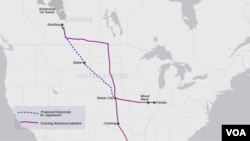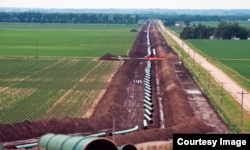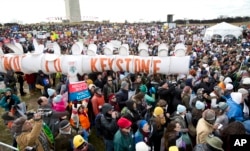President Barack Obama must soon decide the fate of a controversial pipeline that has been stalled by environmental concerns.
The TransCanada Keystone XL Pipeline is an extention to a pipeline that would carry over 800,000 barrels per day of heavy tar sands oil 3,000 kilometers from Canada through the American midwest to refineries on the Gulf Coast.
The pipeline is finished except for the leg that crosses the U.S.-Canada border, which requires the president's signature.
New route
The pipeline was originally planned to run across a major aquifer, putting the water supply for millions at risk. Now TransCanada is back with a new route.
“Allowing the Keystone pipeline to be built requires a finding that doing so would be in our nation’s interest," Obama said in a speech last June. "And our national interest will be served only if this project does not significantly exacerbate the problem of carbon pollution."
The president made those remarks at the launch of his Climate Action Plan, a move to reduce America's contribution to increased carbon emissions in the atmosphere.
“The net effects of the pipeline’s impact on our climate will be absolutely critical to determining whether this project is allowed to go forward," Obama said. "It’s relevant.”
The pipeline would carry over 800,000 barrels of heavy tar sands oil a day. Opponents say mining tar sands uses vast amounts of energy and water and produces much more pollution than conventional oil.
Environmental concerns
Anthony Swift is an energy analyst for the Natural Resources Defense Council, which opposes the pipeline. He says oil from tar sands would generate 240 million metric tons of carbon -- the equivalent of putting five million more cars on the road.
“The whole point of Keystone XL is to get tar sands through the U.S. to the Gulf coast where it can be refined and exported internationally," Swift said. "So, you’re left with increased carbon emissions, risk to our farms and our water sources along the route for very little benefit because it really is an export pipeline.”
But others, like Sabrina Fang at the American Petroleum Institute, disagree. She points to recent polls that show the majority of Americans support the project. She says the pipeline makes good economic sense and won’t put the environment at risk.
“We don’t know why it has been complicated and politicized," she said. "But we are hoping that with this New Year, the president will look at all the facts of this project and see that it will be safe to build. It will be safe to operate and it will create jobs. And, his own State Department has already said that it is safe to build in four previous environmental reviews. And we don’t expect anything different from this fifth one.”
A draft environmental impact statement released by the State Department last March concluded the pipeline would not significantly harm the environment.
However, Swift says 1.2 million people registered their opposition to those findings.
“We know that the impacts of tar sands spills are far more significant than conventional crude spills," he said. "We found that in Mayflower, Arkansas, and Kalamazoo, Michigan, where a tar sands spill of 800,000 gallons [3 million liters] cost over a billion dollar to clean. In fact the Kalamazoo River, over three years after that spill, is still contaminated with tar sands.”
Presidential approval
Oil industry executives are confident that safeguards will minimize such spills. Fang predicts Obama will approve it.
“I think the president, when he looks at this final review, which we expect will mirror the last four reviews saying this is safe to build, I don’t see how he can say that this is not in the nation’s interest to get this pipeline built,” she said.
That worries Anthony Swift.
“What's at stake here is our climate future," he said. "In a large degree, the Keystone XL is a decision on whether we continue pushing increasingly dirty energy sources or move toward clean alternatives.”
Obama will make his decision after a final State Department review.
The TransCanada Keystone XL Pipeline is an extention to a pipeline that would carry over 800,000 barrels per day of heavy tar sands oil 3,000 kilometers from Canada through the American midwest to refineries on the Gulf Coast.
The pipeline is finished except for the leg that crosses the U.S.-Canada border, which requires the president's signature.
New route
The pipeline was originally planned to run across a major aquifer, putting the water supply for millions at risk. Now TransCanada is back with a new route.
“Allowing the Keystone pipeline to be built requires a finding that doing so would be in our nation’s interest," Obama said in a speech last June. "And our national interest will be served only if this project does not significantly exacerbate the problem of carbon pollution."
The president made those remarks at the launch of his Climate Action Plan, a move to reduce America's contribution to increased carbon emissions in the atmosphere.
“The net effects of the pipeline’s impact on our climate will be absolutely critical to determining whether this project is allowed to go forward," Obama said. "It’s relevant.”
The pipeline would carry over 800,000 barrels of heavy tar sands oil a day. Opponents say mining tar sands uses vast amounts of energy and water and produces much more pollution than conventional oil.
Environmental concerns
Anthony Swift is an energy analyst for the Natural Resources Defense Council, which opposes the pipeline. He says oil from tar sands would generate 240 million metric tons of carbon -- the equivalent of putting five million more cars on the road.
“The whole point of Keystone XL is to get tar sands through the U.S. to the Gulf coast where it can be refined and exported internationally," Swift said. "So, you’re left with increased carbon emissions, risk to our farms and our water sources along the route for very little benefit because it really is an export pipeline.”
But others, like Sabrina Fang at the American Petroleum Institute, disagree. She points to recent polls that show the majority of Americans support the project. She says the pipeline makes good economic sense and won’t put the environment at risk.
“We don’t know why it has been complicated and politicized," she said. "But we are hoping that with this New Year, the president will look at all the facts of this project and see that it will be safe to build. It will be safe to operate and it will create jobs. And, his own State Department has already said that it is safe to build in four previous environmental reviews. And we don’t expect anything different from this fifth one.”
A draft environmental impact statement released by the State Department last March concluded the pipeline would not significantly harm the environment.
However, Swift says 1.2 million people registered their opposition to those findings.
“We know that the impacts of tar sands spills are far more significant than conventional crude spills," he said. "We found that in Mayflower, Arkansas, and Kalamazoo, Michigan, where a tar sands spill of 800,000 gallons [3 million liters] cost over a billion dollar to clean. In fact the Kalamazoo River, over three years after that spill, is still contaminated with tar sands.”
Presidential approval
Oil industry executives are confident that safeguards will minimize such spills. Fang predicts Obama will approve it.
“I think the president, when he looks at this final review, which we expect will mirror the last four reviews saying this is safe to build, I don’t see how he can say that this is not in the nation’s interest to get this pipeline built,” she said.
That worries Anthony Swift.
“What's at stake here is our climate future," he said. "In a large degree, the Keystone XL is a decision on whether we continue pushing increasingly dirty energy sources or move toward clean alternatives.”
Obama will make his decision after a final State Department review.







